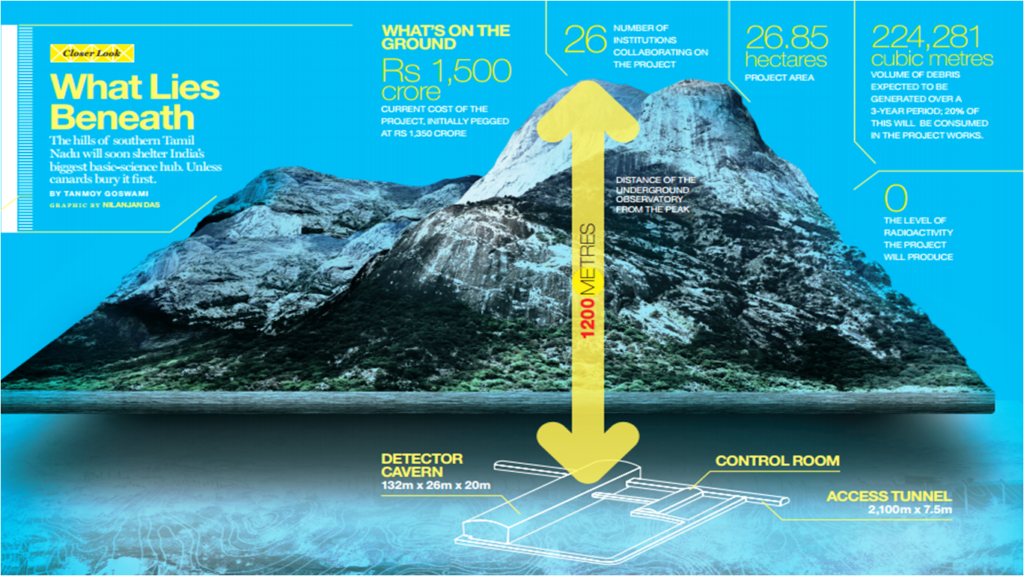Project details
The Neutrino project involving an investment of more than Rs. 15000 million was sanctioned by Government of India under the XIth plan, and the scientists initially hoped to start construction of the facility by 2011. Around 25 research institutions are associated with the project with Tata Institute of Fundamental Research acting as a nodal institution.
The proposed massive neutrino detector will be built in a cavern set in massive charnockite rock ( a group of igneous rocks found in South India with those in TamilNadu known to be the hardest).
The cavern will be excavated by drilling a tunnel of 1.9 to 2 km in length so that there is vertical overburden of about 1300 m.
For a good neutrino detection facility, a vertical cover of at least 1000 m is required, so that the observed neutrino events are not contaminated by unwanted particles that will be absorbed by the overburden.
India-based Neutrino Observatory (INO) will be a major underground experimental facility to study the elusive and nearly massless fundamental particles of nature called neutrinos.
Environmental issues
After initially denying permission to the Department of Atomic Energy (DAE) to locate the India-based Neutrino Observatory (INO) at Singara in Nilgris District in TamilNadu, Ministry of Environment and Forest (MoEF), Government of India accorded both environmental and forest clearance for locating the project in the Bodi West Hills (BWH) in Theni District in TamilNadu.
However, Southern Bench of the National Green Tribunal has recently suspended the environmental clearance granted to the neutrino observatory by the Union Ministry of Environment and Forest (MoEF), due to some objections such as the proposed location being just about 4.9 kilometers from the Madhikettan Shola National Park in Idukki district of Kerala. The Southern Bench of National Green Tribunal has asked the project promoters to submit a fresh application with more details.
The project has also been objected by local people on safety consideration.
The project is suffering prolonged delay.
Apprehension of the protestors
There have been several doubts raised by protestors such as possible radiation from the project and the apprehension that the mountain where the tunnel would be drilled would become unstable.
There are also fears that there would be the use of hazardous chemicals and gasses.
What do scientists say on environmental concerns?
Of course, the scientists promoting the project have stated that such apprehensions of protestors are unjustified.
Scientists say that there will be no radiation emitting from the lab, as the lab is that deep in the earth to keep out radiation.
It is further said that the lab will not affect the structural stability of the mountain. While making the tunnel, the technological advancement will ensure that the environment is left untouched; at the most, the rock blasting will cause flutters, but that won’t last long and normal conditions `will be restored in quick time.
To ensure the safety of the experiment and the people, the gasses will be recycled many times and only then let off in a controlled amount. The equipment and the gasses used for the experiment will be hermetically sealed so that there would be no chance of any pollution/contamination from there.
What do scientists say about the need for the project?
According to the scientists, this India-based Neutrino Observatory is a particle physics research project, proposed to be implemented to study atmospheric neutrinos primarily. The project is anticipated to provide a precise measurement of neutrino mixing parameters.
The field of neutrino physics has attracted worldwide attention, and there is a need to understand many questions put forth by the phenomena of neutrino oscillations.
The Super Kamiokande neutrino observatory in Japan, Sudbury Neutrino Observatory in Canada, Gran Sasso Lab in Italy, and IceCube Neutrino Observatory in the South Pole are some of the existing neutrino laboratories in the world.
As far as India is concerned, this is a Mega Science Project that would enable India to join the group of elite countries that are conducting research on such advanced field, so that India will not be left behind in the global scientific pursuits.
Obviously, the scientists are thrilled about this project, since it would place India in the league of advanced nations who carry out such research project, with China particularly considering such research project as thrust areas for long-term scientific pursuits
What have the scientists failed to say?
Critics seem to be of the view that such advanced science and technology oriented Rs.1500 crore project is only of academic research at this stage, with the end results of the investment and efforts not being precisely known or defined or explained.
Critics wonder whether India should initiate a research activity for the sake of research, while there is a lack of clarity on the outcome.
Common men in the country and the taxpayers expect to be told in precise and quantitative terms about the long-term targets, objectives and envisaged benefits of this program. They seem to think that they only got vague explanations, which only adds to the confusion about the need for such project, even amongst those who are favorably inclined towards research pursuits.
Scientists only say that the project will benefit the country by enhancing India’s scientific manpower. They claim that the use of state of the art technologies in the design and development of the project would build a technologically stronger nation. Beyond that, any sensible explanation involving facts to explain the commercial worthiness of the investments have not been advanced to satisfy the anxious queries from the common men of India.
While the activists and local people seem to be concerned more about the safety issues at this stage, the fact is that the economic and technical justification for the project in a simple style that can be communicated to the ordinary men has been conspicuous by absence. This makes it difficult to difficult to study the cost-benefit analysis of the project.
It is true that, sometimes, the objective of scientific pursuits in a particular direction are more based on expectations and hopes and discovery of unknown factors that may be of importance. Even in such case, this should be explained to the people in straight forward manner. If this investment in neutrino project is a calculated risk from the point of view of commercial terms, let it be told to people.
Many concerned people may support the project even if there would be a calculated risk considering the overall possible benefits.
Lack of communications is the problem
This appears to be a repeated problem in India that the government and the scientific community do not adequately communicate with the common men and local people in transparent style about the objectives of their activities and the risk factors, if any, that are involved.
Lack of transparency and communication with the countrymen and local people is the real cause for delay and controversies in the case of several projects.
Neutrino project is one more example of such approach of the scientific community and the government about the conceived plans for implementation.



0 Comments
LEAVE A COMMENT
Your email address will not be published